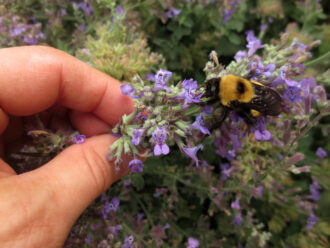With many native pollinator populations on the decline, many farmers are striving to attract beneficial insects that ensure adequate pollination of key crops. Designing on-farm habitats to feature hardy plants that attract pollinators may be one practical method of boosting pollination and protecting yields.
With support from a Western SARE Farmer/Rancher grant, Susan Fluegel of Colfax, Wa., set out to explore whether habitats featuring plant species of varying architectures could influence pollinator abundance and diversity. Plants were intentionally selected for traits such as drought tolerance, long blooming periods, and low maintenance, making them particularly suited to challenging conditions. Using time-lapse video surveillance, Fluegel identified plant species attractive to specific pollinators.
Her research demonstrated that while variety in plant architecture did not seem to make a difference in pollinator abundance, the variety of plant species did significantly influence both the diversity of visiting pollinators and their numbers. Just a few carefully chosen plants could sustain hundreds, sometimes thousands, of pollinator visits in a single 30-minute observation session. These findings reveal an opportunity to inform farmers about selecting plants that can improve both the economic and environmental sustainability of production in areas lacking adequate pollination.
“It’s been eye-opening that these different plants attract such a variety of insects, and that by combining different plants together we can tailor which insects we are attracting and feeding,” says Fluegel. “If I’m in an area where the leaf cutter bee is in danger of going extinct, I can look for plants that will help this particular native bee.”
Fluegel shared her findings in a short booklet, Increase Crop Yields by Managing Pollinator and Beneficial Insect Habitat in the Pacific Northwest. Fluegel also presented her work at pollinator summits, inspiring local farmers to adopt similar practices. Despite barriers such as the COVID-19 pandemic limiting in-person outreach, her efforts have motivated growers to plant native species that support pollinators and, in turn, their crops.
A recent post-project evaluation of SARE projects awarded between 2016–2019 found that the farmer-friendly approach of SARE grants was key to conducting the project.
Visit https://www.sare.org/sare-impacts-FW18-030 for more information on this project's impact.
Does More Diverse Plant Architecture in Pollinator Habitats Influence Native Pollinator and Beneficial Insect Abundance and Diversity? is part of a series of 23 case studies produced by Insight for Action as part of a post-project evaluation of SARE's regional grant programs. Visit https://www.sare.org/sare-impacts for further details.
For information on grants and resources available from SARE, visit www.sare.org.
